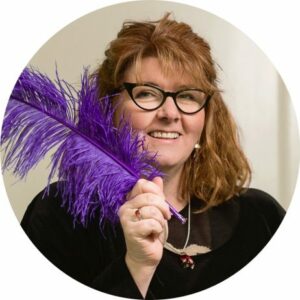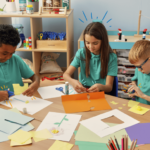
I can remember the first time I had a class, it was reception in Brighton, when in a class of 35 children I had a child who seemed ill at ease, sensitive, and contrasting to the rest of the children.
It’s important to acknowledge at this point in a class of 35, 4-year-olds the differentiation is massive. There are children who are confident, who already know how to interact, count, read. There are a few who come from households where any behavioural response has been accepted. There are children from older parents, living in foster homes, a whole plethora of needs specific and unique to each of them.
My little one with Autism didn’t particularly stand out in the mixture of personalities and needs, but as the lead educator it’s our job to notice the actions, the words and the emotions of each child.
It is our job as educators to become aware of each child, to know each child and to try and bring learning to life in ways each of them are able to respond to.
Developing Our Knowledge
Working with little Joe (not his real name) meant I needed to understand his needs. I read what I could, accessed courses (not many available) and spoke to anyone who had experience of supporting a child with these needs.
A little bit of history.
The word “autism” is taken from the Greek word autos, meaning “self.” It was first used by Eugen Bleuler, a Swiss psychiatrist, in 1908. Bleuler used the
term to describe patients he worked with who seemed absorbed in their inner world, disconnected from reality, and withdrawn from social interaction.
Around 1943 Leo Kanner, an Austrian-American psychiatrist, published a seminal paper describing a group of children with similar characteristics, such as social withdrawal, communication difficulties, and repetitive behaviours.
Around the same time as Kanner’s work, Hans Asperger, an Austrian paediatrician, described a similar condition in children, which became known as Asperger syndrome.
Over the decades, the term “autism” evolved as researchers and clinicians gained a deeper understanding of the condition. It took until 2013 for the body of health professionals working in this field to agree a single diagnosis of autism spectrum disorder (ASD), emphasizing that autism exists on a spectrum with varying levels of severity and support needs.
It is a real challenge to support individual children with Autism, each child is unique with their own ‘set’ of differences.
Autism is a spectrum, meaning it affects individuals differently, and the severity of challenges can range from mild to more significant. Early intervention, tailored support, and therapies can help address these challenges and improve the child’s development and quality of life.
Some children with Autism may have intellectual disabilities, while others may have average or above-average intelligence. Often the children have social and communication challenges and find interactions difficult. They may demonstrate traits, behaviours, that make them stand out like rocking or hand flapping. They also may have heightened or diminished sensory sensitivity.
At the time I had little Joe in my class, (1993/94) the term neurodiversity had not yet been coined. Judy Singer an Australian sociologist and autistic self-advocate began to use the term in 1998.
Neurodiversity is the concept that neurological differences, such as autism, ADHD, dyslexia, and other cognitive variations, are part of the natural spectrum of human diversity rather than disorders or deficits that need to be “fixed.” The concept emphasises the idea that there is no single “normal” brain or mind, and that variations in how people think, process information, and experience the world should be accepted and respected.
For now, back to little Joe. Like many children with Autism, he demonstrated the main areas that I could consider, research, plan for and support.
Social Communication and Interaction: Like many other children little Joe struggled with understanding and using social cues, such as facial expressions, tone of voice, and body language.
We introduced small group gathering in the morning with visuals of each child, added to our Circle of Friendship board. Joe loved to hold the board, while his classmates added their photos. He saw each of them approach to add their photo without having to communicate verbally.
Mirror Work
We also had a welcome mirror. Each child could take time to look at themselves in the mirror, often two friends would do it together, some children chose not to use it at all but Joe decided when and if he would say hello to himself and know that he was in a different space.
Joe also had difficulty in making and maintaining friendships, understanding the emotions of his classmates and was not confident in conversations, he struggled with the back and forth of chat.
We introduced the Chatter Box
This was a box containing two (toy) microphones, two phone handsets (we didn’t have mobiles yet!!) two voice recorders, two Buttons with a light switch (my hubby made it, when one child had their finger on the button, the light went on, they talked when the light when off the other child decided to respond or not by pressing their button).
I still use a chatter box now, but it is full of fabulous resources that encourage this process.
Behaviour and Interests: Many children with autism exhibit repetitive behaviours (such as hand-flapping, rocking, or repetitive speech), and they may have very focused interests, often to the exclusion of other topics.
Little Joe would do anything around Thomas the Tank Engine. He could talk endlessly about it. We used this as a catalyst in all his learning as often as possible.
Some of these behaviours can also extend to rigid routines and resistance to change. A disruption to familiar patterns can lead to stress or anxiety.
Joe had a visual flip book for the routines we had around the class and the infant department too. I was very aware of signalling the order and rhythm of the day and any change to the routine. Obviously not always getting it right.
The final main challenge we had was Sensory Sensitivities.
Joe did not like a noisy classroom. Here lay a real challenge with 35 excited and highly stimulated 4-year-olds. We made sure to have 3 small coy nooks around the room. We often found Joe in these spaces but as the year progressed and we all got to know one another the class settled to realise when they had become too noisy, three or four of them noticing Joe in his little nooks and asking the other children to quieten down.
Many children with autism may experience heightened or diminished sensitivity to sensory stimuli. For example, they might be extremely sensitive to certain sounds, lights, textures, or smells, or they may seek out sensory input, like spinning or touching objects repeatedly.
This is where we must fully reflect on the number of materials, resources and equipment we put out around our learning spaces. How much choice and how many decisions do we need our children to have? Are you overwhelming them? Are our spaces interfering with the engagement rather that helping it?


